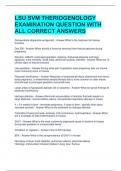LSU SVM THERIOGENOLOGY
EXAMINATION QUESTION WITH
ALL CORRECT ANSWERS
Domperidone (dopamine antagonist) - Answer-What is the treatment for fescue
toxicosis
Day 300 - Answer-When should a horse be removed from fescue pastures during
pregnancy
Abortion, stillbirth, prolonged gestation, dystocia, thickened placenta (red bag),
agalactia, mare mortality, weak foals, abnormal cyclicity, infertility - Answer-What are 10
clinical signs of fescue toxicosis
Late gestation - Answer-During what part of gestation does pregnancy loss via trauma
most commonly occur in horses
Placental insufficiency - Answer-Reduction of endometrial/villous attachment from twins,
body pregnancy, or endometrial atrophy/fibrosis that is more common in older mares
and will lead to prolonged gestation and small foals
Large areas of hypoplastic/aplastic villi on placenta - Answer-What are gross findings of
placental insufficiency
Hydrops allantois - Answer-Abnormal accumulation of allantoic fluid with leads to a
large abdomen, ventral midline edema, and potential respiratory distress in mares
If > 2-4 weeks to term - terminate pregnancy, if close to term - partially drain (poor
neonatal survival) - Answer-What is the treatment for hydrops allantois
Torticollis of head and neck, scoliosis, limb contracture, hydrocephalus - Answer-What
are 4 examples of fetal malformations in horses
EHV1 - Answer-What is the most commonly diagnosed cause of abortion in horses
during late gestation in unvaccinated herds
Inhalation or ingestion - Answer-How is EHV spread
80% - Answer-What is the seroprevalence of EHV1 in horses
Necropsy of fetus: focal hepatitis, pulmonary edema, placental edema
Histology: intranuclear inclusion bodies in lung, liver, thymus
,VI, PCR, fetal serology - Answer-What diagnostics can be used to detect EHV as the
cause of abortion in horses
Every 2 months on large farms, 3/5/7/9 months gestation - Answer-When should horses
be vaccinated for EHV in general and while pregnant
Hygiene (reduce fomite transmission), segregate farm population by age or stage of
gestation, reduce stress (avoid transport), quarantine new arrivals - Answer-What are 4
ways to prevent the spread of EHV1
Major: venereal, inhalation
Minor: vertical, fomites - Answer-What are the major and minor routes of transmission of
equine viral arteritis
Mild fever, edema, nasal discharge - Answer-What are the clinical signs in a mare with
EAV (in any) besides abortion
70-90% in STB, <3% in TB - Answer-What is the seroprevalence of EAV in horses
Second half of gestation - Answer-When do abortions occur that are caused by EAV
VI, serology, RT-PCR of lung, liver, placenta, or fetal fluids - Answer-What diagnostics
are used to detect EAV as the cause of abortion
Preventing carrier stallions (vaccinate colts between 6 and 12 mo) - Answer-What is the
most important part of EAV management
equine viral arteritis, contagious equine metritis - Answer-What infectious causes of
pregnancy loss are reportable
Contagious equine metritis - Answer-Infectious cause of pregnancy loss in horses
caused by taylorella equigenitalis and is transmitted venereally, congenitally, and via
fomites
0-7 months - Answer-When in gestation will abortions caused by CEM occur
Serology, culture of clitoral sinuses/cervix/endometrium - Answer-What diagnostics can
be used to determine CEM as the cause of abortion in mares
Late - Answer-Equine placentitis is one of the more common causes of ____ gestation
pregnancy loss in the mare in the US
Vulvar discharge, premature mammary development, abnormal placenta around
cervical star - Answer-What are 3 signs of placentitis
, Ascending placentitis - Answer-Type of placentitis where bacteria (strep equi
zooepidemicus) migrates through the cervix to the cervical star; organisms can cross
placenta
Focal mucoid placentitis/nocardioform placentitis - Answer-Type of placentitis where the
infection originates at the base of the gravid horn; organisms do not cross placenta;
adherent tan exudate
Combined thickness of the uterus and placenta (CTUP) - Answer-Measurement that
can be taken via ultrasound to determine if it is a high risk pregnancy when compared to
the gestational age; it will show if there is exudate between the uterus and
chorioallantois
Total progestagens - Answer-Incremental rises in ____ ____ prior to 310 days gestation
correlates with placental pathology
Normal, compromised, dead (or severely compromised) - Answer-If a mare's total
estrogens during pregnancy are >1000ng/mL that indicates a ____ fetus, between 500-
800ng/mL indicates a ____ fetus, and <500ng/mL indicates a ____ fetus
Incr Ca with high Na and low K: abnormal pregnancy
Incr Ca with low Na and high K: about to foal - Answer-If milk Ca increases but milk Na
and K are high and low respectively what does that indicate? What if milk Na is low and
K is high?
CTUP, fetal heart rate (fetal distress), progestagen measurement, estrogen
measurement, milk Ca testing - Answer-List all of the ways that abnormal pregnancies
(placentitis) can be diagnosed
Progestins (regumate), NSAIDs, broad spectrum antibiotics (K+ penicillin, gentamicin,
fluoroquinolones), pentoxifylline - Answer-How should the mare be treated for placentitis
Treat as septicemic when born (antibiotics, supportive care, etc) - Answer-How should
the foal be treated after birth when the mare had placentitis
Small for gestational age but not septic like ascending placentitis - Answer-What is the
outcome for the foal in the mare had nocardioform placentitis
Aspergillus - Answer-What is the most common cause of mycotic abortion? -
hematogenous or transcervical spread, dry/thick/leathery placental lesions
Skunks, raccoons, cattle - Answer-What animals carry the leptospirosis serovars that
are responsible for abortions in mares
Late gestation - Answer-What stage of gestation do abortions caused by lepto occur




